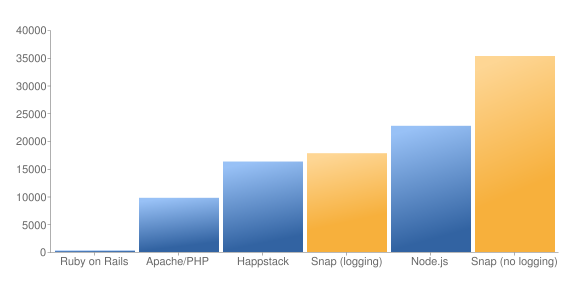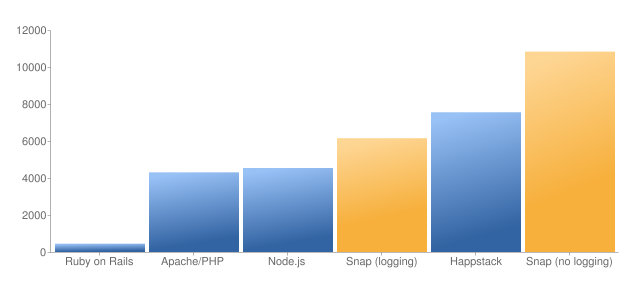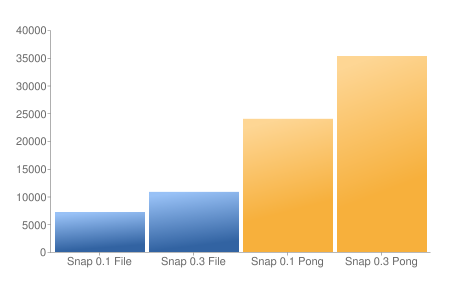EDIT: Updated the numbers for Apache/PHP using PHP 5.3.3 and using echo instead of printf. Also re-ran Rails with version 3.0.3. Performance improved in both cases, but not enough to change the rankings.
The recent release of GHC 7.0.1 features some significant performance improvements, and because the Snap benchmarks have not been updated since we released six months ago we thought it would be a good time to do so. We kept as many things constant as possible, including benchmarks (pong and file), hardware, OS (although the kernel version is probably different), and httperf options.
Pong Benchmark
First let’s look at the results for the pong benchmark. The units are replies/second, higher numbers are better. We should note that we are benchmarking Snap 0.3 which is still in development and scheduled for release in January.

| RoR | Apache+PHP | Happstack | Snap (logging) | Node.js | Snap (no logging) |
| 288 | 9769 | 16299 | 17800 | 22733 | 35316 |
If you’re comparing this with our previous results you will notice that we left out Grails. We discovered that our previous results for Grails may have been too low because the JVM had not been given time to warm up. The problem is that after the JVM warms up for some reason httperf isn’t able to get any samples from which to generate a replies/sec measurement, so it outputs 0.0 replies/sec. There are also 1000 connreset errors, so we decided the Grails numbers were not reliable enough to use.
Happstack has improved since the last benchmark, but it has a problem where performance decreases under heavy loads. We discovered that using an httperf rate of 34 almost doubles happstack’s performance on the pong benchmark compared to the rate of 1000 used to test all the other frameworks. This brings it to within about 10% of Snap’s numbers. But on these benchmarks we’re more interested in a server’s performance under heavy load than it’s peak throughput in optimal conditions, so our graphs show the numbers for a rate of 1000. The Happstack guys are planning to investigate this issue in the near future.
One source of variation among applications is whether they do access logging or not. Ruby on Rails, Node.js, and Happstack do not do any access logging. Our previous Snap benchmarks also did not have access logging turned on. But Apache does write access logs, so we decided to add a second entry for Snap with access logging to facilitate a more accurate comparison.
File Benchmark
Here are the results for the file benchmark. Again, higher numbers are better.

| RoR | Apache+PHP | Node.js | Snap (logging) | Happstack | Snap (no logging) |
| 450 | 4308 | 4540 | 6152 | 7554 | 10832 |
The relative performance of the frameworks stays pretty much the same, except that Happstack is good at serving files, while Node.js is slower. We didn’t try to figure out what rate would optimize Happstack’s throughput on the file benchmark, but it seems reasonable to assume that it won’t make as big of a difference here as it did with pong.
After we published the last results comments here and here suggested that it is unfair to benchmark Rails with the Webrick server and that we should use Thin/Mongrel/nginx+passenger instead. Benchmarking best of breed against best of breed is certainly a useful thing to do, but it is also useful to benchmark a similar level of effort. Webrick is the out-of-the-box server for Rails, so it seems fair to compare this with Snap’s out-of-the-box solution. I was able to benchmark Thin and it performed worse than webrick. Another person got similar results and also found that Webrick beat Mongrel as well. We did not benchmark nginx+passenger because that requires significant configuration and doesn’t qualify as an out-of-the-box solution. We also tried to benchmark the Play web framework but it generated an InternalError exception and stopped responding to requests.
Snap Comparison
So what has happened to Snap since our last benchmarks in May? Here is a chart comparing the performance of Snap 0.1 and 0.3.

On the pong benchmark we went from 23,997 to 35,316 (replies/sec), a 47% improvement. The file benchmark improved from 7,206 to 10,832, a 50% improvement. We were curious to see how much of this came from improvements to Snap and how much was from better GHC code generation. When compiled with GHC 6.12.3 the pong benchmark gets 33196 replies/sec. So upgrading to GHC 7.0.1 gave us a drop-in 6% performance improvement.
This time all of our Snap runs used the runtime options “+RTS -A4M -N4”. The new version of GHC eliminated the need for the “-qg0 -qb -g1” that we used before. Also, we were really looking forward to the new IO manager that is in GHC 7.0.1, and hoping that it would eliminate the need for our libev backend. Unfortunately our libev backend still performs significantly better, so we will continue to ship it.
For those who are interested, here are the versions of the software we used:
- Ruby on Rails 3.0.3
- Grails 1.2.2
- Apache 2.2.17
- PHP 5.3.3
- Node.js 0.2.4
- Snap 0.3
- Play 1.1
Full results are here. Or visit the snap-benchmarks github repository if you want the code.